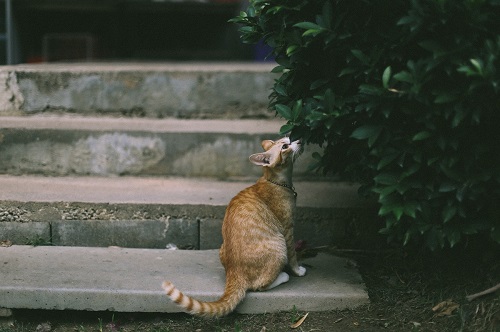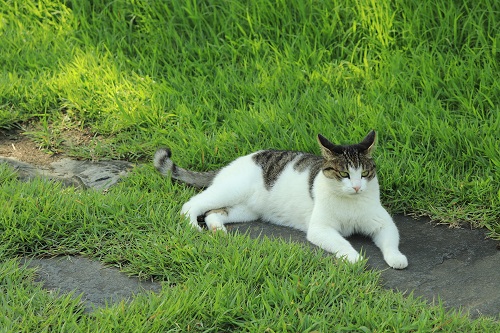You may think it’s just for looks, but the truth is, your cat uses his tail for just about everything. From balance to proper bathroom etiquette, your cat relies on his tail for many daily tasks, and he even uses it to communicate. As a result, a tail injury can be catastrophic for a feline. But how will you know if your cat’s tail is even injured? In the following article, we will address some of the most common tail injuries for cats and tell you what to keep an eye on should you suspect a tail injury.
Types of Cat Tail Injuries
The most common categories of tail issues for cats are as follows:
Breaks – characterized by a break in the chain of vertebrae or by a fracture in one of the vertebrae itself. Breaks occur to the interior of the tail and can be caused by blunt impact, i.e. someone stepping on it, or swift misdirection like getting caught in a door.
Mutilation (external/self-inflicted) – characterized by cuts, abrasions, skin loss, and hair loss. Mutilation occurs on the exterior of the tail and can be caused by external sources like other animals, or it can be self-inflicted due to skin conditions.
Accidental amputation – characterized by the complete or partial removal of a section of the tail. This is often the case with cat tail injuries at the tip where only part of the tail has been affected. Amputation is most commonly the result of interaction with machinery like a fan or a car.
Accidental amputation can pose itself as a complicated matter, especially if a piece of the tail is still slightly attached. If your cat  suffers from a partially amputated tail, do not try and remove the rest of the tail. Whether or not the tail can be saved is a decision your vet must make. After any tail injury, it is in your cat’s best interest to go to the vet as quickly as possible. However, an accidental amputation of the tail can lead to greater health risks and must be dealt with immediately.
suffers from a partially amputated tail, do not try and remove the rest of the tail. Whether or not the tail can be saved is a decision your vet must make. After any tail injury, it is in your cat’s best interest to go to the vet as quickly as possible. However, an accidental amputation of the tail can lead to greater health risks and must be dealt with immediately.
Common Causes of Cat Injuries
How would my cat even incur such injuries? Below are three of the most common ways cats incur tail injuries:
Mutilation
Mutilation often comes as the result of an external source. Unfortunately, a cat’s tail is slender enough to get caught in places it shouldn’t be like fans, doorways and even the mouth of another animal. Mutilation from other animals is a fairly typical cat tail injury that can be characterized by puncture wounds and bite marks.
Self-mutilation is characterized by a cat purposefully tearing up his tail. Most commonly, this self-mutilation is driven by the presence of a skin condition or external irritant. In an attempt to alleviate the pain, your cat will claw and bite his tail. He might even go so far as to rub his tail against foreign objects. Here are some of the visible signs of a self-mutilated tail:
- Lack of fur at the base of the tail
- Visible skin
- Raw skin that is irritated and red
- Scabs and open sores
A self-mutilated tail is most commonly the result of a feline food allergy or cat fleas. These two leading causes of skin issues traditionally attack the base of the tail. The bottom of the tail is where you will find a majority of the self-mutilation, but it can extend up the tail as well.
If you notice your cat is biting and scratching his own tail, attempt to find the source of the discomfort. Work with your veterinarian to eradicate the source of discomfort with a new flea medicine or a new diet. Additionally, look into topical treatments that will help reduce inflammation, irritation, and other cat skin conditions.
Automobile Injuries
If dogs are the natural enemy of cats, then cars are a feline’s mechanical nightmare. You may be wondering how this could be, considering you always find your cat somewhere around your vehicle. Whether he is sunning himself on the hood in the early  morning, or finding shady solace underneath the body of a parked car, your car puts your cat at risk of significant tail injury.
morning, or finding shady solace underneath the body of a parked car, your car puts your cat at risk of significant tail injury.
Unfortunately, cats do not understand the real power of automobiles. Often, due to his curiosity and constant desire to find a warm, comfortable hiding place, your cat will put himself in harm’s way. Aside from the threat of potentially being run over, your car poses a lesser-known threat to your cat and his tail.
The engine of your car is propelled by a fan belt, which runs along the bottom of your engine. If your cat is underneath your vehicle when it starts up, the noise of the engine could startle him and his tail could get caught in the fan belt. This, in turn, could lead to tail degloving, a broken tail or even part of the tail being ripped entirely off.
Cat tail injuries are typically very minor, but in rare situations, your cat’s tail could become the victim of serious injury. If your cat hurts his tail be sure to seek emergency medical attention right away. While a tail injury may seem dire, many cats make a full recovery from tail injuries and go on to lead very normal lives. Your cat is resilient but just in case, do your best to keep him, and his tail, out of harm’s way.
Sources:
“7 Common Cat Tail Injuries.” PetMD, 22 Jan. 2018, https://www.petmd.com/cat/emergency/accidents-injuries/7-common-cat-tail-injuries.
Thompson., Ellen. “How to Treat a Cat Tail Injury.” PetCareRx, 8 Dec. 2013, https://www.petcarerx.com/article/how-to-treat-a-cat-tail-injury/1515.
“Tail Trauma in Cats – Symptoms, Causes, Diagnosis, Treatment, Recovery, Management, Cost.” WagWalking, 30 Nov. 2016, https://wagwalking.com/cat/condition/tail-trauma.
“How To Treat A Cat Tail Injury Properly.” My Pet Needs That, 7 Jan. 2019, https://www.mypetneedsthat.com/how-to-treat-cat-tail-injury/.
“7 Facts About Your Cat’s Tail.” Pets Global, 4 Jan. 2017, https://www.pets-global.com/?p=1072.




